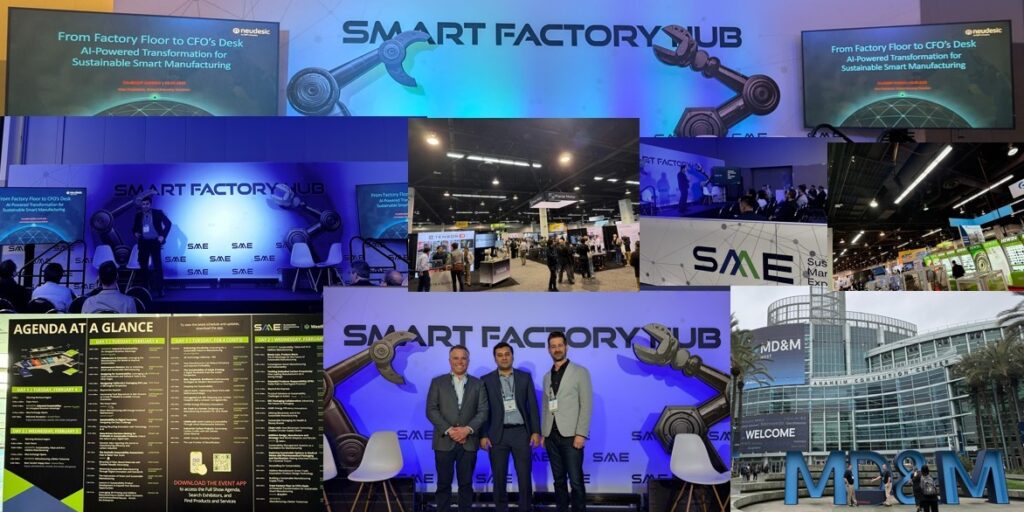

Manufacturers are forced to rethink how they operate as a result of rising global supply chain disruptions, increasing regulatory requirements, and the push towards net zero emissions. To address these increased demands, Industry 5.0 marks a new era where human expertise works together with AI, IIoT, and automation—transforming manufacturing into a data-driven, resilient, and sustainable industry. At the Sustainable Manufacturing Expo, we explored how agentic AI and the Industrial Internet of Things (IIoT) are the catalysts driving this transformation, enabling manufacturers to make proactive, data-driven decisions in real-time.
These technologies don’t just improve efficiency; they also create a more resilient, sustainable manufacturing environment. AI-powered predictive maintenance reduces downtime, IIoT-enabled connectivity enhances visibility across operations, and intelligent automation streamlines processes. The result? A factory floor that operates with greater precision, lower waste, and higher profitability.
3 current challenges in manufacturing
While the benefits of AI and IIoT are clear, manufacturers must navigate several challenges to fully modernize their operations. Below are three main challenges:
1. Sustainability pressures
Manufacturers today must balance production demands with environmental responsibility, a challenge that grows more complex as regulations tighten and consumer expectations shift toward sustainable, eco-friendly products. Companies must find ways to reduce energy consumption, minimize waste, and lower carbon emissions—all while staying profitable. Without the right tools, these goals can seem unattainable, leaving businesses vulnerable to rising costs, regulatory penalties, and loss of market trust. Adopting smart, data-driven solutions is essential for long-term success and competitiveness in a rapidly evolving industry.
2. Operational inefficiencies
Inefficient processes drive higher costs, lower productivity, and wasted resources, making it harder for manufacturers to stay competitive. Many factories still rely on manual operations and outdated systems, leading to production bottlenecks, slower turnaround times, and increased risk of human error. Without modernization, these inefficiencies compound, resulting in missed deadlines, excessive downtime, and shrinking profit margins. To keep up with demand and maintain a competitive edge, manufacturers need smarter, automated solutions that optimize workflows, improve accuracy, and ensure seamless production cycles.
3. Data silos and lack of real-time insights
Many manufacturers struggle with disconnected systems that prevent data from flowing across different departments. This results in delayed decision-making and missed opportunities to improve efficiency. Without a centralized data system, businesses cannot react quickly to production issues, supply chain disruptions, or changes in demand. This disconnect leads to delayed responses, excess inventory costs, and missed revenue opportunities—outcomes that AI and IIoT can effectively prevent. Real-time visibility is essential to streamline operations and stay ahead of challenges.
4 impacts of agentic AI and IIoT on manufacturing
To overcome modern manufacturing challenges, companies must shift from traditional, reactive approaches to data-driven, intelligent automation. Agentic AI and IIoT work together to enhance efficiency, optimize decision-making, and create more resilient, agile operations. Here are four ways that agentic AI and IIoT modernize manufacturing:
1. Enhances predictive maintenance
Traditional maintenance strategies are often reactive, meaning machines are fixed only after they break down—leading to unplanned downtime and costly repairs. For example, in automotive manufacturing, predictive AI can flag anomalies in CNC machines that produce precision parts, allowing intervention before defects escalate. In the energy sector, AI-driven monitoring of turbines and compressors can reduce failures, avoiding costly unplanned shutdowns. By analyzing real-time machine data, AI can detect early warning signs of equipment failure, allowing manufacturers to:
- Prevent unplanned downtime by scheduling proactive repairs.
- Extend equipment lifespan through smarter maintenance strategies.
- Reduce operational costs by minimizing wasted time and resources.
This shift from reactive to predictive maintenance improves reliability and ensures continuous production without costly interruptions.
2. Optimizes supply chain management
A well-functioning supply chain is the backbone of any manufacturing operation. However, disruptions—whether from raw material shortages, transportation delays, or market fluctuations—can cause major setbacks. These challenges are particularly evident in industries like semiconductor manufacturing, where delays in raw silicon shipments can stall entire production lines, or automotive manufacturing, where supply chain bottlenecks in microchip availability have led to months-long production slowdowns. IIoT and AI-driven analytics provide end-to-end visibility into supply chains, enabling manufacturers to:
- Predict and mitigate risks by analyzing trends and demand patterns.
- Enhance inventory management by tracking materials in real time.
- Reduce waste and inefficiencies by optimizing procurement and logistics.
With AI-powered supply chain insights, businesses can adapt quickly to disruptions, ensuring smooth operations and on-time product delivery even in volatile markets.
3. Improves quality control
Ensuring high product quality is critical for maintaining customer trust, regulatory compliance, and cost efficiency. Defective products not only lead to expensive recalls and rework but can also damage a brand’s reputation. In industries like pharmaceutical manufacturing, even minor inconsistencies in tablet composition can result in failed regulatory inspections and costly batch rejections. In automotive production, undetected welding defects in chassis components can lead to large-scale recalls, impacting safety and profitability. AI-driven quality control systems use real-time sensor data and machine learning to:
- Detect defects early before faulty products reach customers.
- Identify patterns in production issues to prevent recurring problems.
- Optimize manufacturing processes to improve consistency and precision.
By integrating AI-powered monitoring and automated quality checks, manufacturers can increase production accuracy, reduce waste, and enhance overall product reliability.
4. Drives sustainability through smart manufacturing
Sustainability is no longer just a corporate responsibility—it’s a competitive advantage. AI and IIoT technologies enable smarter energy use, helping companies reduce their carbon footprint while improving efficiency. AI-driven energy management systems analyze power consumption patterns and automatically adjust usage to minimize waste. Additionally, predictive analytics can reduce material waste by optimizing production schedules, ensuring that raw materials are used efficiently. These advancements not only help businesses meet regulatory requirements but also support long-term cost savings and environmental goals.
The roadmap to full modernization
To guide manufacturers through the transition from legacy systems to fully modernized, data-driven operations, the Industrial Modernization Maturity Model outlines five key stages:
- Legacy Industry – Siloed systems and manual processes dominate operations.
- Digital Connectivity – IoT-enabled monitoring begins, providing initial data insights.
- System Integration – IT and OT merge, allowing seamless data flow across departments.
- Automation – AI, robotics, and machine learning optimize operations and predictive maintenance.
- Control Tower – Real-time analytics and AI-driven decision-making create a fully autonomous, data-driven manufacturing environment.
Where does your organization stand on this roadmap? Each stage presents an opportunity for greater efficiency, sustainability, and profitability. Moving toward automation and AI-powered decision-making isn’t just about keeping up—it’s about staying ahead.
Measuring success with smart manufacturing KPIs
To ensure continuous improvement, manufacturers must track key performance indicators (KPIs) across procurement, production, logistics, sales, finance, and energy efficiency. Some of the most critical KPIs include:
- Overall Equipment Effectiveness (OEE): Measures machine uptime and efficiency.
- Total Delivered Cost (TDC): Tracks logistics and supply chain expenses.
- Specific Thermal Energy Consumption (STEC): Monitors energy efficiency for sustainability.
- Predictive Maintenance Alerts: Helps prevent unplanned downtime and costly repairs.
By leveraging real-time data analytics, manufacturers can identify bottlenecks, optimize production, and make strategic decisions based on accurate insights.
Case study
A global process manufacturing conglomerate recently modernized its operations using a scalable, intelligent IIoT platform. Before the transformation, the company struggled with manual processes, siloed data, and inefficient KPI tracking, leading to delayed decision-making and increased operational costs.
To address these challenges, we implemented an AI-powered IIoT solution provided real-time visibility across all levels of production. Features such as predictive maintenance, digital twin simulations, and IT/OT integration helped the company:
- Reduce downtime by 25% through predictive maintenance.
- Improve production efficiency by 15% with AI-driven optimizations.
- Lower operational costs by 10% through better resource management.
- Enhance product quality with real-time monitoring and automated adjustments.
This case study demonstrates that modernization isn’t just a technological upgrade—it’s a strategic necessity. Companies that invest in AI and IIoT will see tangible benefits, from cost savings to sustainability improvements.
The future of smart, sustainable manufacturing
The integration of Agentic AI and IIoT represents the next major leap in manufacturing. By embracing these technologies, companies can achieve higher efficiency, reduce waste, and ensure sustainability—all while maintaining a competitive edge.
The question is no longer if manufacturers should modernize but how quickly they can accelerate the journey. Companies that successfully integrate Agentic AI and IIoT today won’t just reduce costs—they’ll set the standard for next-generation, sustainable manufacturing.
But where does your organization stand on the Industrial Modernization Maturity Model? Are you still operating with siloed, legacy systems, just beginning to leverage IIoT for data-driven insights, or already using AI-driven automation for predictive decision-making? No matter your current stage, the next step is critical. By assessing existing operations, identifying AI-driven opportunities, and building a scalable transformation roadmap, manufacturers can stay ahead in an industry that demands efficiency, agility, and sustainability.
Is your company ready for the future of manufacturing? Now is the time to assess your current operations, identify areas for improvement, and start implementing the smart solutions that will define the next era of industrial excellence.
Related Posts